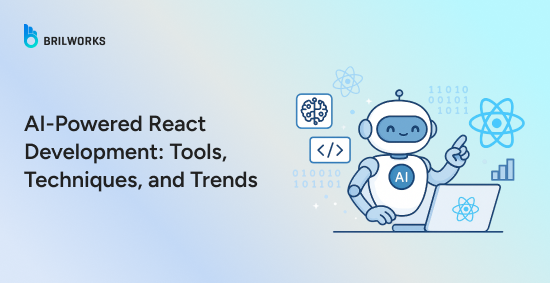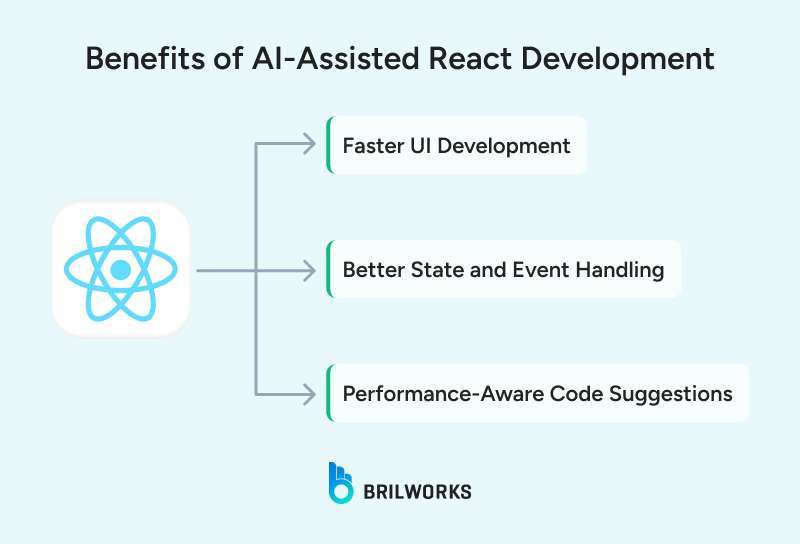COOPERATION MODEL
ARTIFICIAL INTELLIGENCE
PRODUCT ENGINEERING
DevOps & Cloud
LOW-CODE/NO-CODE DEVELOPMENT
INDUSTRY
FRONTEND DEVELOPMENT
CLOUD DEVELOPMENT
MOBILE APP DEVELOPMENT
LOW CODE/ NO CODE DEVELOPMENT
EMERGING TECHNOLOGIES








AI is quietly but powerfully influencing React development, assisting developers in writing code, generating test cases, and optimizing workflows. This article explores how developers are adapting to this shift with emerging libraries, techniques, and industry practices.
AI is expanding across industries, from simple automation tools to advanced development workflows. A prominent example comes from Google itself, where Sundar Pichai recently revealed that around 30% of code at Google is written by AI.
Tech giants are investing billions to push AI-powered development toward autonomy, where AI could eventually code full applications. While this may take a decade, the trend is clear: developers and companies that ignore AI risk being left behind.
Backend AI has evolved rapidly, but frontend development is not far behind. ReactJS’s modular, component-based architecture makes it well-suited for integrating AI, a shift highlighted in React 19 AI features. New APIs like Actions and Directives provide smoother pathways for AI functionality, making React's core compatible with AI-driven development.
Developers must stay informed to leverage this transition effectively. This article guides you through integrating AI into React.js projects and understanding emerging tools and practices.
ReactJS is one of the most admired UI libraries for building dynamic, interactive interfaces. Primarily used for single-page applications, React accelerates development through pre-built libraries and a component-based architecture that simplifies complex UI construction.
Even with this modular structure, challenges remain, including state management, boilerplate code, and asynchronous workflows. React 19 addresses some of these complexities while creating room for AI-powered enhancements.
React’s evolution is introducing new ways to incorporate intelligent tools into the development process. While full automation is not yet the goal, AI is increasingly functioning as a co-developer rather than just an assistant.
With React 19, AI integration is smoother thanks to new APIs:
use(): Handles asynchronous data elegantly, allowing components to suspend rendering until the required data is available. This is particularly useful in server components and simplifies data-fetching logic for both developers and AI tools.
Actions: Provides declarative, structured server mutations such as form submissions, reducing the need for manual wiring of handlers. This enables AI models to generate and interact with predictable business logic efficiently.
Directives: Introduces a declarative approach for attaching low-level DOM behavior to JSX elements. AI tools can now inject interactive features such as tooltips, focus traps, or scroll effects without extra boilerplate or refactoring.
AI has become central to personalization and dynamic content delivery, powering systems like YouTube recommendations or Instagram feeds. For instance, Amazon's recommendation engine drives around 35% of its sales, illustrating how AI can optimize user experiences and conversions.
AI-based workflows are being adopted across industries to accelerate product development, increase accuracy, and improve efficiency.
React’s latest updates allow AI to actively contribute in several areas:
AI tools such as GitHub Copilot X can generate complete components using React 19 patterns. For example, a developer asking for a sortable table may receive a fully functional component utilizing the useOptimistic() hook.
React 19 introduces improvements that make it easier to control client- and server-side logic. AI tools such as Vercel’s AI engine can analyze component structures and suggest:
When to memoize components
Where to separate client and server logic
How to minimize unnecessary re-renders
Intelligent Testing
AI is also enhancing testing workflows. React 19 improves the act() API and simplifies async data handling with use(), enabling AI tools to:
Generate test cases
Detect bugs
Perform visual regression checks
Copilot generates code from plain descriptions, suggests improvements, writes test cases, and can produce entire files. It supports declarative state management in React, recommending libraries and code patterns for developers.
Tabnine operates locally, learning from your codebase to offer context-aware suggestions while respecting coding patterns. It integrates seamlessly with React design systems.
Cursor reduces repetitive coding tasks, assisting with class component refactoring and optimizing hooks directly within VS Code.
Vercel v0 is a prompt-based UI code generator. It creates React components with Tailwind CSS and supports other frameworks like Vue, Remix, and Svelte. Generated JSX can be deployed directly from the Vercel dashboard.
|
Tool |
Use Case in React |
AI Capability |
|---|---|---|
|
GitHub Copilot |
Code generation, testing |
Suggests full components |
|
Tabnine |
Context-aware suggestions |
Learns from your codebase |
|
Cursor AI |
Refactoring hooks |
Reduces manual tasks |
|
Vercel v0 |
JSX/Tailwind component generation |
Prompt-based UI creation |

Faster UI Development: AI reduces repetitive tasks and can generate design-aware components, minimizing layout errors.
Better State and Event Handling: New APIs such as useOptimistic and Actions provide structure that makes AI integration easier, especially for form logic and asynchronous flows.
Performance-Aware Suggestions: AI analyzes component behavior, flags potential bottlenecks, and recommends optimizations without manual profiling.

A Jellyfish survey (May 2025) found 90% of engineering teams now use AI in their workflows, up from 61% a year earlier. Nearly half now use two or more tools, reporting 25–62% productivity improvements.
According to Atlassian's 2025 DevEx report, 68% of developers save at least 10 hours weekly using AI.
The Wall Street Journal and Gartner describe a trend called “vibe coding”, where UIs are generated directly from natural language prompts. Gartner predicts that 40% of new business software will originate from AI-assisted workflows within three years.
Perplexity AI mandates tools such as Cursor and Copilot, reducing prototyping timelines from days to hours. The global AI-in-software-development market was valued at $674 million in 2024 and is projected to reach $15.7 billion by 2033, a CAGR of 42%.
React 19 creates opportunities where human intuition and machine precision can work together. UI prototyping, performance-aware code suggestions, and intelligent testing are just a few areas where AI can support workflows.
If your team aims to modernize legacy front ends or accelerate development using AI in React, now is the time to consider hiring developers who understand React’s evolution and AI integration.
As a trusted web app development company in India, we provide staff augmentation and dedicated ReactJS development services for startups and mid-sized businesses, helping teams fill skill gaps efficiently. Connect with us to hire React JS developers experienced in AI-driven development.
No, React 19 does not have AI capabilities built-in but its new architectural changes makes AI integration in React app a bit easier. React's latest APIs like the use() and useOptimistic hooks, Actions do not have AI capabilities.
AI tools are increasingly capable of handling React Server Components (RSCs) more effectively. In earlier versions, the separation between server and client logic was unpredictable. With React 19, AI tools can better interpret when a component should run on the server, which parts can be streamed or suspended, and how state or actions should be handled.
Tools like Copilot and Cursor work best with React 19. These tools are better at suggesting logic for form handling, async behaviors, and component streaming because the APIs they're working with are now more declarative.
Get In Touch
Contact us for your software development requirements
Get In Touch
Contact us for your software development requirements